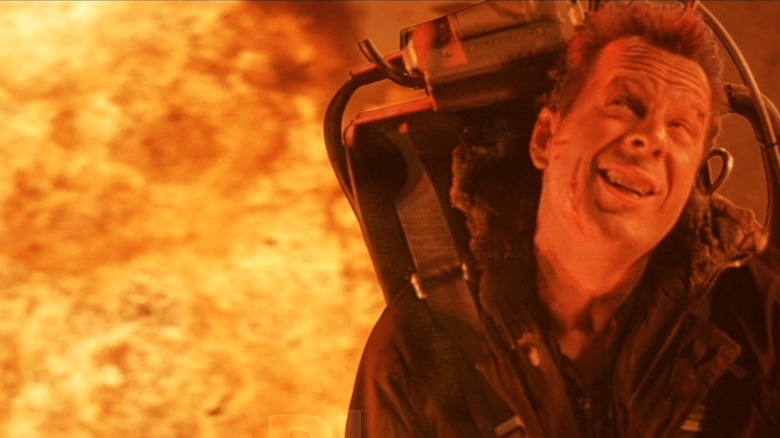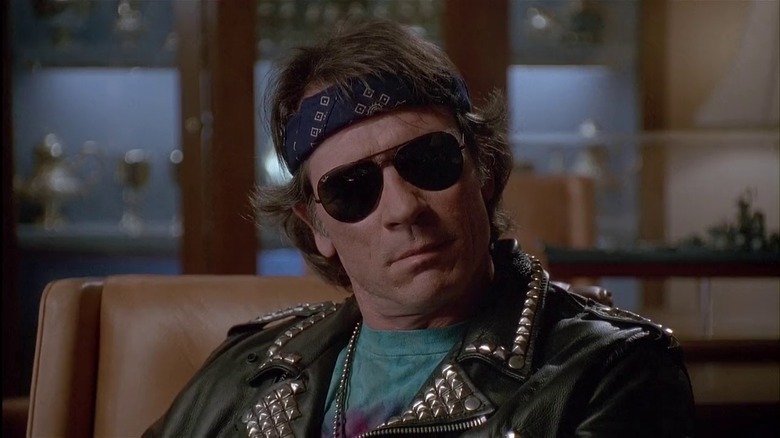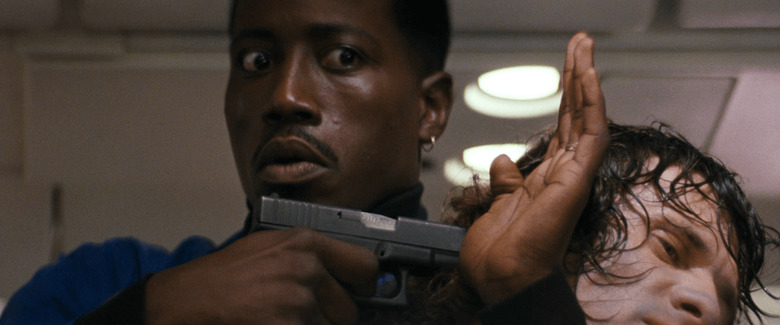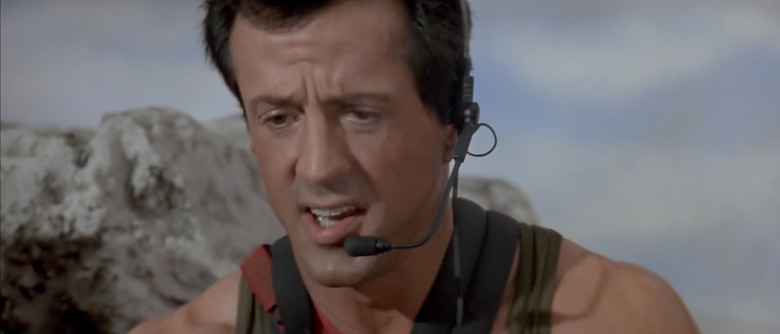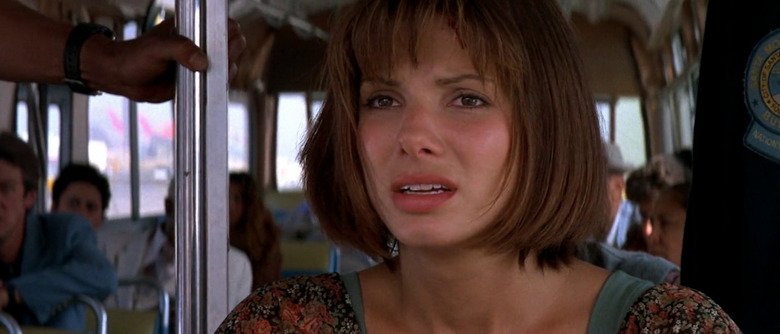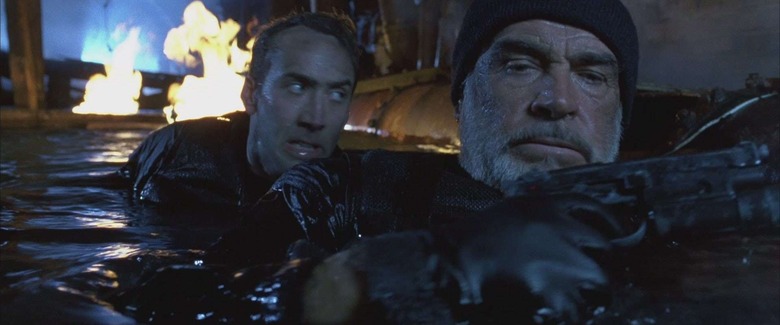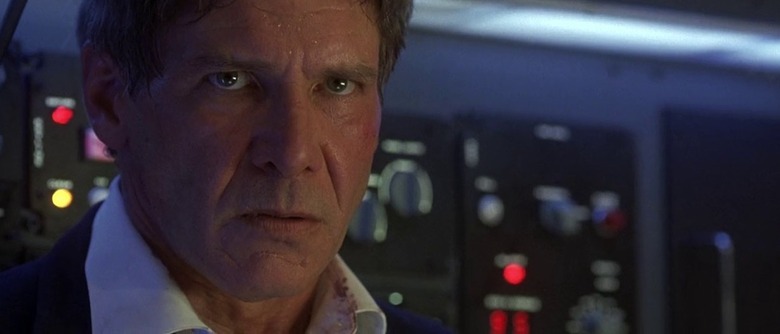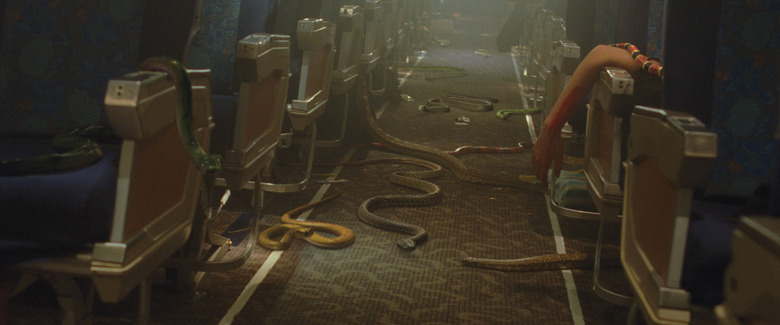The 9 Best And Worst 'Die Hard' Knock-Offs
(This week marks the 30th anniversary of Die Hard, arguably the greatest action movie of all time. To celebrate, /Film is exploring the film from every angle with a series of articles. Today: examining the film's legacy through the numerous rip-offs and knock-offs it inspired in the '90s.)
If you've ever seen the Honest Trailer for Die Hard, then you may recall the lightning round of references at the end riffing on how it was "the original masterpiece that inspired countless knockoffs." Director John McTiernan's 1988 film redefined Bruce Willis as an action star and gave rise to a pervasive action-movie formula in which the proverbial one man *epic movie trailer voice* is trapped in a single setting with a bunch of bad guys.
Owing to this, the movie's title has become a metonym used to refer to other flicks with similar plots. "Die Hard on a plane, Die Hard on a train," etc. If you grew up during the heyday of '90s action movies like I did, then it's possible you may have been snapping open Blockbuster Video cases to watch some of these flicks at home in your living room before you ever even saw Die Hard or realized that it had influenced them.
As we celebrate its 30th anniversary here on /Film, let's take a look back at nine key instances from the '90s where Hollywood movies recapitulated the Die Hard formula and in some cases launched or reinvented the careers of other notable action movie stars and franchises. Viewed with an appreciation for genre history, these nine derivative actioners (coupled with some honorable mentions from the '90s and beyond) still hold rewatch value, while illuminating special aspects of Die Hard and showing how it was the gift that kept on giving.
Spoilers for all of these movies lie ahead.
Die Hard 2 (1990)
It's only fitting that we should kick off this list with the movie that ushered in the '90s wave of Die Hard imitators. Yes, Die Hard 2 is an actual Die Hard film, but the lesser crime of self-imitation (goofily expressed by the film's tagline and sometimes subtitle, "Die Harder,") doesn't make it immune to the Die Hard metonym.
This is "Die Hard in an airport." That setting is another reason why Die Hard 2 is an appropriate choice for the first entry on this list. The film involves hero John McClane contending with henchmen in the airport while his wife's plane and other incoming air traffic circles overhead, unable to communicate with ground control or land on the airport's darkened runways. Only after McClane first lights the way in an explosive fashion are the planes able to start touching down.
In the first Die Hard, McClane was an untested hero drawn into extraordinary circumstances. Far from being invincible, he could be and was memorably hurt, cutting up his bare feet on broken glass, dragging a trail of his own blood behind him. The very existence of Die Hard 2 somewhat undermines the vulnerability and credibility of the character because the audience knows that he has already been through another ordeal like this and survived.
Saving the day is now a regular old Christmas Eve tradition for John McClane. As the movie puts it, being "the wrong guy in the wrong place at the wrong time" has become "the story of his life." Like a private citizen solving TV murders on a weekly basis, the fresh "Yippee-ki-yay" thrill of the first movie gets diluted when the same cop (more often than not, off-duty) keeps getting drawn into increasingly improbable adventures.
Honorable mention: Live Free or Die Hard (2007). An older, shaven-headed Willis returns to the role of McClane to find the terrorists have gone cyber.
Under Siege (1992)
In real life, Steven Seagal is now a Russian citizen who has been accused of sexual harassment in the last year by actresses like Julianna Margulies, Portia de Rossi, and Jenny McCarthy. He's been exiled largely to the direct-to-video market in the 21st century, but there was a time when Seagal ruled the roost as an action star and the movie that brought him into the mainstream is Under Siege.
It's a movie that's rightly been labeled "Die Hard on a battleship." The funny thing is, while Seagal is ostensibly the star of the film, his character — a Navy SEAL turned ship's cook — only has 41 minutes of screen time. It's actually Tommy Lee Jones, clad in a bandana, black shades, and a rhinestone-studded leather jacket, who steals the show here as terrorist Bill Strannix. Jones would re-team with director Andrew Davis the next year for his Oscar-winning role in The Fugitive. He was on the upswing, and with Gary Busey lending him zany support (at one point, Busey even appears in drag), he delivered a villain cut from the same scene-chewing cloth as Hans Gruber.
Like Die Hard, the villain's plan and the seemingly outmatched hero's attempts to foil it drive the whole plot of Under Siege. Disguised as an entertainer, Strannix hides in plain sight at first, similar to how Gruber effortlessly dons the American accent of "Bill Clay" to try and trick McClane. He's also one step ahead of negotiators, able to call up secret missile launch codes to show he's in control.
Honorable mention: Under Siege 2: Dark Territory. The third Die Hard film was originally supposed to be set on a cruise ship but after the success of Under Siege, it had to be reimagined. With Jeremy Irons playing the new surrogate Gruber, Die Hard with a Vengeance took to the streets for a furious New York cab ride, whereas Under Siege 2 was content to remain confined to a single location: namely, a train. By 1995, this series had become more Die Hard than Die Hard.
Passenger 57 (1992)
Wesley Snipes always was ahead of the genre curve. 20 years ago, Blade served as a forerunner of the 21st-century superhero movie boom, and before that, Passenger 57 pioneered the "Die Hard on a plane" movie. With a 22% rating on Rotten Tomatoes, Passenger 57 hasn't maintained the best critical legacy, but if you hadn't seen New Jack City, you could be forgiven for thinking this was Snipes' signature role pre-Blade.
The character he plays, John Cutter, is the kind of guy whose idea of an airplane book is The Art of War and who shows himself to be equally quick with a kick and a quoteworthy quip ("Always bet on black"). When the inevitable hijacking comes, he improvises a plan to force a landing by dumping the plane's fuel. Five years later, Harrison Ford would enact the same plan in Air Force One. Passenger 57 also makes a stopover at a Louisiana airfield, allowing it to detour to a country fair, and it's amazing we didn't see more "Die Hard in a fairground" films after this.
The terrorists in Passenger 57 are a mixture of British and French. Their leader, Charles Rane, is profiled through expository dialogue as, "The sophisticated British aristocrat known as the Rane of Terror." Responsible for two airline bombings in the past year? Don't sell him short: he's "been responsible for twice that amount" (meaning, uh, four?)
Hans Gruber's German accent clearly made an impression on Hollywood screenwriters. With this and other Die Hard knockoffs, there's almost a xenophobic streak to them where you've got terrorists with foreign accents going up against an all-American action hero.
In Passenger 57, there's a meta moment where the terrorist played by Elizabeth Hurley (you read that right) remarks on her accent, saying, "Between you and me, I've been trying to lose it for years. It makes me sound cold and heartless." Correction: it makes you sound like one of many Gruber-inspired villains.
Cliffhanger (1993)
Cliffhanger recycled Renny Harlin, the director of Die Hard 2, for a movie with a clever title that immediately invokes suspense while also being appropriate to the movie's "Die Hard on a mountain" milieu. The VHS cover for this film literally showed Sylvester Stallone hanging off a cliff. With five Rocky films and three Rambo films behind him, Cliffhanger came at a time when Stallone was starting to branch out and diversify his action portfolio.
Guardians of the Galaxy Vol. 2 fans who have never seen this film are in for a retroactive Ravagers reunion, as Michael Rooker (Yondu) plays the best friend of Stallone's character, Gabe. Both men are rangers who get conscripted at gunpoint into helping a gang of thieves whose plane has gone down, scattering three suitcases full of $100 million on a mountain in the Colorado Rockies. Like McClane, Gabe is a regular guy who's not normally cut out for this sort of thing.
Cliffhanger is the movie I always referred back to in my head when I heard that John Lithgow had been cast as a serial killer in Dexter. In the mid-to-late '90s, Lithgow was known as a comedic actor for his work on 3rd Rock from the Sun, the NBC sitcom where Joseph Gordon-Levitt also got his start. Yet as the leader of the bad guys in Cliffhanger, his ruthless, dead-eyed character exudes superior intelligence, much like Alan Rickman's did. Motivated by greed rather ideology, he's actually a truer corollary for Gruber, who only feigned terrorism as a robbery distraction.
Honorable Mention: Daylight (1996). Stallone's last film before his outside-the-box performance in Cop Land is a good example of the Die Hard scenario involving mother nature. This one's "Die Hard in a tunnel."
Speed (1994)
Pop quiz, hotshot: what's the most quotable film influenced by Die Hard? Speed is such a great high-concept action thriller that it almost feels like a disservice to affix it with the "knockoff" label. If you reduce the movie's plot down to the most basic terms, however, it does start to look like Die Hard repackaged again.
"There's a bomb on a bus." This time the location we're trapped in is on wheels, and it can't go below 50 miles per hour or else it will explode. What a beautiful metaphor for the action genre.
The terrorist this time is a lone nut, brought to life by Dennis Hopper. Here, Hopper dials down the deranged, manic energy of his performances in Blue Velvet and Apocalypse Now into a less unhinged, more precision brand of craziness. He's still got that glint in his eye but the character he plays this time has a sober edge, which allows him to funnel his evil intellect into bomb-making. Surrogate Gruber, thy name be Howard Payne.
After Point Break, Keanu Reeves started to rein in his surfer dude persona; this movie lopped off his hair and gave him a buzz cut worthy of a SWAT officer. Speed refreshingly departs from the Die Hard formula by giving a woman a more active role in the film. Sandra Bullock broke big after this blockbuster. Her character, Annie Porter, is still relegated to the damsel in distress (note how she gets taken hostage like McClane's wife; this happens to numerous other wives and love interests on this list), but she's at least allowed to be funny and take the bus's wheel, not to mention the sequel's helm.
Honorable mention: Speed 2: Cruise Control (1997). At 3% on the Tomatometer, it's hard to recommend this one, but hey, at least we finally got to see that "Die Hard on a cruise ship." Willem Dafoe, anyone?
Sudden Death (1995)
In Sudden Death, Jean-Claude Van-Damme re-teamed with the director of Timecop for one of the more ridiculous riffs on the Die Hard recipe that the action cinema of the 1990s produced. This one's "Die Hard in a hockey arena." Yes, it does feature a kidnapper dressed as the mascot for the Pittsburgh Penguins, and yes, Van Damme's martial arts-savvy fire marshal (just roll with it) does fight the penguin mascot, who tries variously to feed his nose into a meat-slicer, slide his face onto a sizzling stove, and dunk his head in a bubbling deep fryer.
Death by dishwasher: what a way to go. Van Damme's character is no stranger to playing dress-up, either, as the plot conspires to put him in goalie gear and have him take to the ice in the middle of Game 7 of the Stanley Cup Finals (all while a mad bomber holds the Vice President hostage in the owner's box above the rink). As much as the requisite member of the authorities on a phone outside the arena might say, "We are gonna do this by numbers," Sudden Death goes to some absurd lengths to distinguish itself.
To its credit, the movie does flip the script on foreign accents by giving the protagonist a French Canadian lilt and casting Powers Booth, a Texan, as the terrorist mastermind. This time the damsel in distress is the hero's daughter, and like Cliffhanger, there is a climactic showdown involving the hero, the villain, the damsel, and a helicopter. As much as these movies cribbed from Die Hard, they also cannibalized each other.
Executive Decision (1996)
Arguably his only other decent film, Executive Decision nonetheless earned Steven Seagal a Razzie nomination. Yet in a shocking twist given his level of fame at the time, his character is killed off early in the movie as the Army special ops unit he is leading transfers mid-air to a hijacked jumbo jet from an experimental stealth plane.
This film really belongs to Kurt Russell, who received top billing (Seagal's name noticeably wasn't featured in the opening credits, even as he ran around slitting throats). Russell boasted his own action-movie pedigree, of course, via '80s cult classics like Escape from New York and Big Trouble in Little China. However, he was 30 when he donned the eyepatch to play Snake Plissken and now he was 45 and wearing a pair of bookish spectacles.
Dr. David Grant, the Army Intelligence consultant he plays, is another character cast in the McClane mold. Neither musclebound nor a martial arts master, Grant has more of an everyman quality that harkens back to McClane and serves as a reminder of how he subverted the physical image of an action hero. Prior to Die Hard, Bruce Willis was known more for his TV dramedy work on Moonlighting, just as Michael Keaton was known more for his comedy work in films like Beetlejuice before he assumed the mantle of Batman.
Honorable Mention: Breakdown (1997). Russell rides a Jeep straight into a "Die Hard on a desert highway" scenario.
The Rock (1996)
The AV Club called The Rock "the one good movie Michael Bay ever gave us." That might be a back-handed compliment, but it does seem to sum up the critical consensus about Bay's directorial work. The Rock (not to be confused with the new Dwayne Johnson Die Hard knockoff, Skyscraper) is one action movie that left an impression and that's got to count for something.
One of the things The Rock has going for it is the interplay between Sean Connery and Nicolas Cage's characters. John McClane may lack the physique of a bodybuilder but he does have detective-level police experience and that's more than can be said for Cage's lab rat, Dr. Stanley Goodspeed. Like Dr. David Grant in the previous entry on this list, Goodspeed is brought in as a consultant to a military unit (this time it's Navy SEALs, not Army Special Forces). He soon learns that he will have to accompany them to Alcatraz Island on what will eventually become a "Die Hard in a prison" mission.
The buddy-movie dynamic between him and Connery's character provides an interesting twist on the usual one-man Die Hard scenario. Having a corny schlub team up with the first big-screen James Bond allows for a different kind of wish fulfillment. It's as if Sgt. Al Powell (the character played by Family Matters actor Reginald VelJohnson in Die Hard) is tagging along with McClane and receiving life-coaching from him about what "winners" do with the prom queen. Ed Harris makes for a more principled, sympathetic Gruber surrogate but he's still after money ($100 million again).
Honorable mention: Con Air (1997). Yet another "Die Hard on a plane" movie, albeit one stacked with a who's who list of '90s character actors.
Air Force One (1997)
"Harrison Ford is ... the President of the United States." Gary Oldman is ... Russian Hans Gruber. That's an oversimplification, obviously: Oldman is too talented an actor to let his character fall into some mere parody of another action movie villain. That doesn't change the fact that he's playing yet another terrorist with a foreign accent.
Air Force One has been called "Die Hard on the President's plane." Though he seems like the kind of interview subject who would gruffly rebuke such a conjecture, there had to have been some kind of wish fulfillment aspect to this film for Ford, who is a licensed pilot in real life. What other role would allow him to crawl into the cockpit of the most important plane on the planet?
Like the heroism in all these movies, it's the ultimate male fantasy. He's not only the leader of the free world; he's also a Vietnam vet with aviation experience who is capable of single-handedly taking on a plane full of bad guys, sneaking around and picking them off like John McClane. To be fair, McClane was friendlier, given to spouting one-liners like, "Welcome to the party, pal," whereas Ford's character, the authoritatively named President Marshall (our real-life President's favorite on-screen president, for what that's worth), is more likely to make an angry face and say, "Get off my plane," before shoving a guy right out of the parachute ramp.
Years later, Ford would again follow the action-movie trail blazed by Bruce Willis when he flew in a helicopter to offer a bit of consolation casting for the lack of Willis in The Expendables 3.
21st Century Knock-Offs
Popular tastes are ever-changing and in terms of box office supremacy, the great deluge of Die Hard knockoffs in the 1990s has largely given way to what's been called a "tsunami of superhero movies" in the 21st century. Still, there are a few high-profile examples of action films that have continued to carry the ball downfield from Die Hard into the new millennium. These three merit a mention before we wrap up.
Snakes on a Plane (2006). To paraphrase Samuel L. Jackson's character in Snakes on a Plane: "You know all those [Die Hard] scenarios we ran? Well, I'm smack in the middle of one we didn't think of." Maybe seeing Snake Plissken on a plane in Executive Decision planted the subliminal seed for this movie, which came along ten years later in an attempt to reverse-engineer a cult classic from an awesome-sounding title. Jackson does his thing but this is one of those ideas that might have made a better Grindhouse trailer than something stretched out to feature length.
Olympus Has Fallen (2013) and White House Down (2013). Like Deep Impact and Armageddon fifteen years earlier, Olympus Has Fallen and White House Down offered up competing tentpole releases with the same idea the same year. Now that "Die Hard on the President's plane" had already been done, the next logical move was for some able-bodied movie studio to crank out "Die Hard in the White House." So they did that ... twice. Of the two flicks, Olympus Has Fallen earns brownie points for being first out of the gate; having a star with more of an action-movie pedigree (Gerard Butler); getting Morgan Freeman to act as President again; and spawning a sequel (London Has Fallen). But be honest, would you really notice if you fell asleep on the plane during this movie and woke up in the middle of White House Down (or any other movie on this list)?
They're all Die Hard. Everything is everything and it all goes back to Die Hard. If there's anything reboots and shared universes have taught us, it's that Hollywood has a tendency to exploit a successful business model until it's been done to death.

